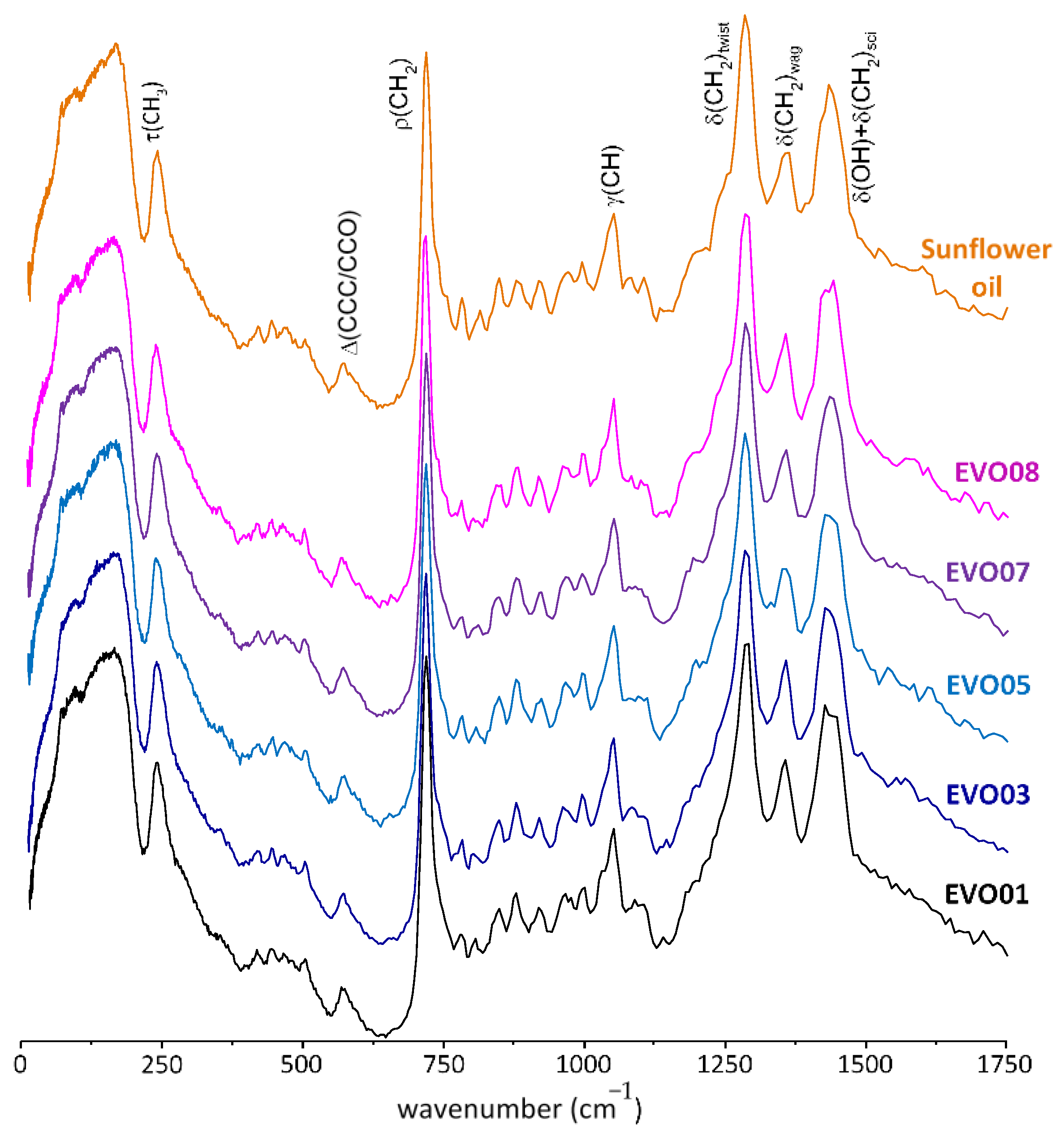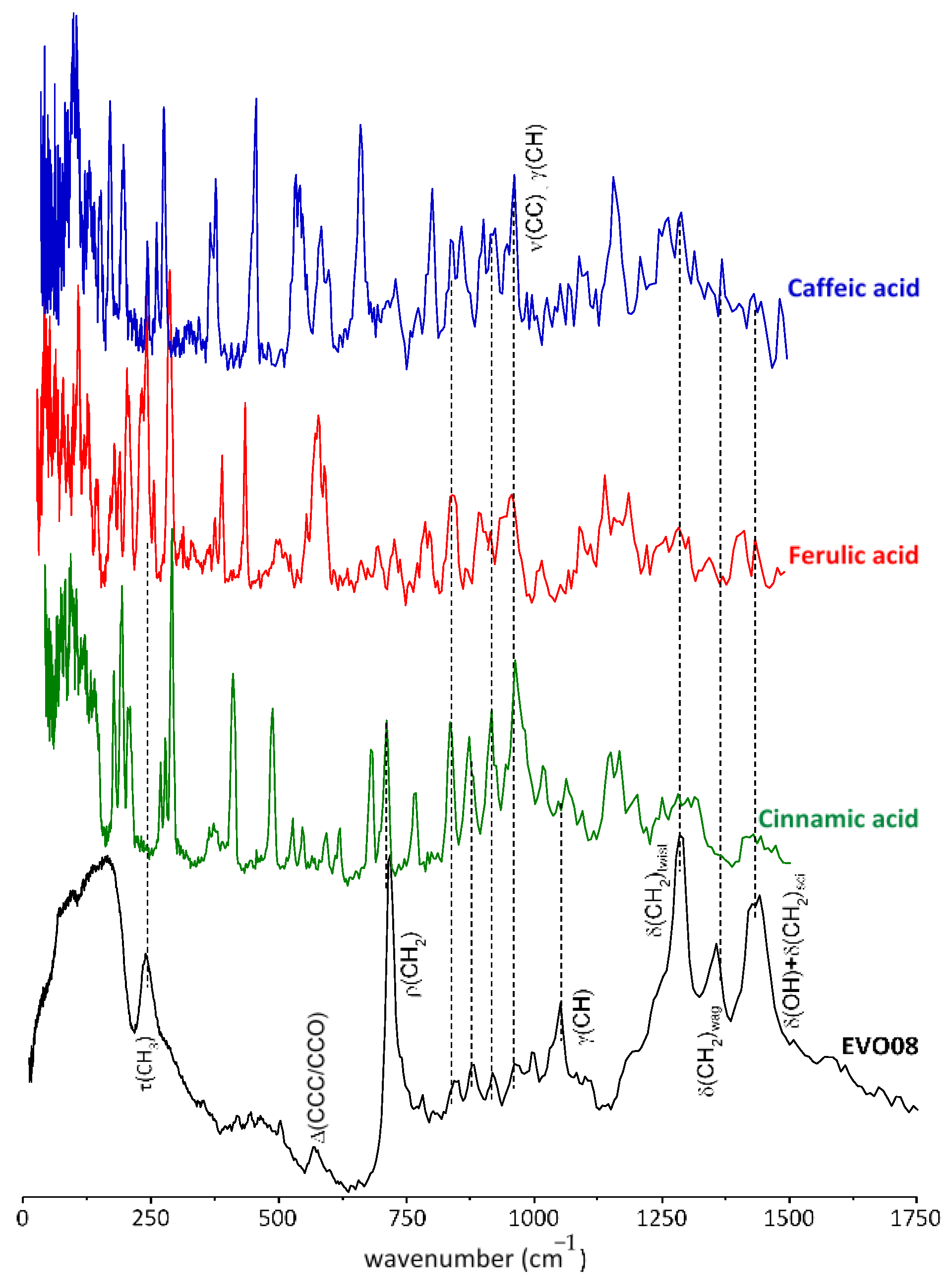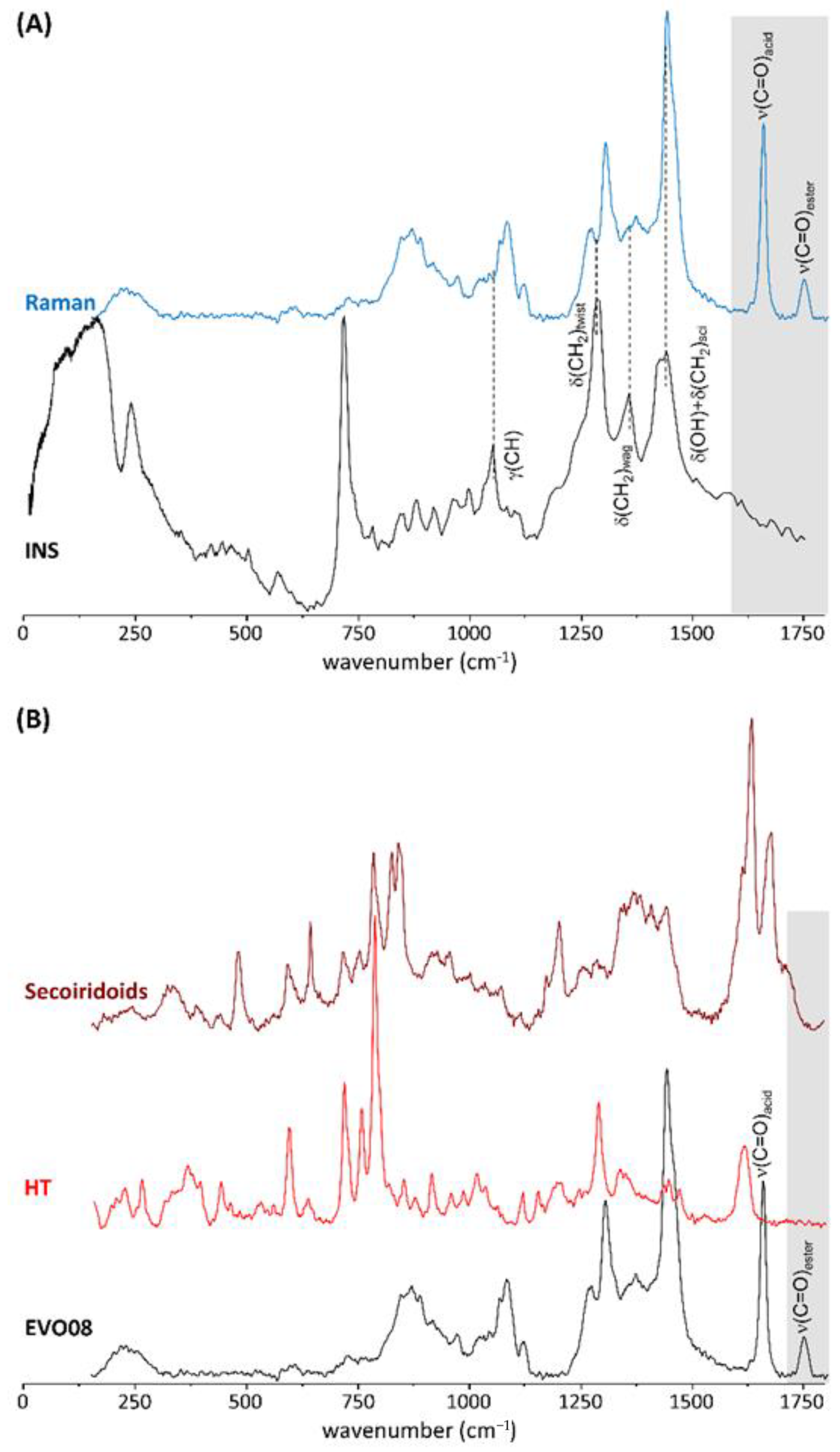Looking for Minor Phenolic Compounds in Extra Virgin Olive Oils Using Neutron and Raman Spectroscopies
Abstract
1. Introduction
2. Materials and Methods
2.1. Materials
2.2. INS Spectroscopy
2.3. Raman Spectroscopy
2.4. UV-Vis Absorbance
3. Results and Discussion
4. Outlook and Conclusions
Author Contributions
Funding
Institutional Review Board Statement
Informed Consent Statement
Data Availability Statement
Acknowledgments
Conflicts of Interest
References
- Gomes, C.A.; da Cruz, T.G.; Andrade, J.L.; Milhazes, N.; Borges, F.; Marques, M.P.M. Anticancer Activity of Phenolic Acids of Natural or Synthetic Origin: A Structure−Activity Study. J. Med. Chem. 2003, 46, 5395–5401. [Google Scholar] [CrossRef] [PubMed]
- Fresco, P.; Borges, F.I.G.M.; Diniz, C.G.; Marques, M. New insights on the anticancer properties of dietary polyphenols. Med. Res. Rev. 2006, 26, 747–766. [Google Scholar] [CrossRef] [PubMed]
- Fresco, P.; Borges, F.; Marques, M.P.M.; Diniz, C. The anticancer properties of dietary polyphenols and its relation with apoptosis. Curr. Pharm. Des. 2010, 16, 114–134. [Google Scholar] [CrossRef]
- Servili, M.; Sordini, B.; Esposto, S.; Urbani, S.; Veneziani, G.; di Maio, I.; Selvaggini, R.; Taticchi, A. Biological Activities of Phenolic Compounds of Extra Virgin Olive Oil. Antioxidants 2014, 3, 1–23. [Google Scholar] [CrossRef]
- Batista de Carvalho, A.L.M.; Caselli, F.; Rodrigues, V.; Paiva-Martins, F.; Marques, M.P.M. Antiproliferative Activity of Olive Oil Phenolics against Human Melanoma Cells. Lett. Drug Des. Discov. 2017, 14, 1053–1059. [Google Scholar]
- Di Daniele, N.; di Renzo, L.; Noce, A.; Iacopino, L.; Ferraro, P.M.; Rizzo, M.; Sarlo, F.; Domino, E.; de Lorenzo, A. Effects of Italian Mediterranean organic diet vs. low-protein diet in nephropathic patients according to MTHFR genotypes. J. Nephrol. 2014, 27, 529–536. [Google Scholar] [CrossRef]
- Andreoli, A.; Lauro, S.; di Daniele, N.; Sorge, R.; Celi, M.; Volpe, S.L. Effect of a moderately hypoenergetic Mediterranean diet and exercise program on body cell mass and cardiovascular risk factors in obese women. S.L. Eur. J. Clin. Nutr. 2008, 62, 892–897. [Google Scholar] [CrossRef] [PubMed]
- Di Daniele, N.; Noce, A.; Vidiri, M.F.; Moriconi, E.; Marrone, G.; Annicchiarico-Petruzzelli, M.; D’Urso, G.; Tesauro, M.; Rovella, V.; de Lorenzo, A. Impact of Mediterranean diet on metabolic syndrome, cancer and longevity. Oncotarget 2017, 8, 8947–8979. [Google Scholar] [CrossRef]
- Di Daniele, N.; Petramala, L.; di Renzo, L.; Sarlo, F.; della Rocca, D.G.; Rizzo, M.; Fondacaro, V.; Iacopino, L.; Pepine, C.J.; de Lorenzo, A. Body composition changes and cardiometabolic benefits of a balanced Italian Mediterranean Diet in obese patients with metabolic syndrome. Acta Diabetol. 2013, 50, 409–416. [Google Scholar] [CrossRef]
- Oliveras-López, M.J.; Innocenti, M.; Giaccherini, C.; Ieri, F.; Romani, A.; Mulinacci, N. Study of the phenolic composition of spanish and italian monocultivar extra virgin olive oils: Distribution of lignans, secoiridoidic, simple phenols and flavonoids. Talanta 2007, 73, 726–732. [Google Scholar] [CrossRef]
- Owen, R.W.; Haubner, R.; Würtele, G.; Hull, W.E.; Spiegelhalder, B.; Bartsch, H. Olives and olive oil in cancer prevention. Eur. J. Cancer Prev. 2004, 13, 319. [Google Scholar] [CrossRef]
- Fabiani, R.; de Bartolomeo, A.; Rosignoli, P.; Servili, M.; Selvaggini, R.; Montedoro, G.F.; di Saverio, C.; Morozzi, G. Virgin Olive Oil Phenols Inhibit Proliferation of Human Promyelocytic Leukemia Cells (HL60) by Inducing Apoptosis and Differentiation. J. Nutr. 2006, 136, 614–619. [Google Scholar] [CrossRef]
- Han, J.; Talorete, T.P.N.; Yamada, P.; Isoda, H. Anti-proliferative and apoptotic effects of oleuropein and hydroxytyrosol on human breast cancer MCF-7 cells. Cytotechnology 2009, 59, 45–53. [Google Scholar] [CrossRef] [PubMed]
- Sepporta, M.V.; Fuccelli, R.; Rosignoli, P.; Ricci, G.; Servili, M.; Morozzi, G.; Fabian, R. Oleuropein inhibits tumour growth and metastases dissemination in ovariectomised nude mice with MCF-7 human breast tumour xenografts. J. Funct. Foods 2014, 8, 269–273. [Google Scholar] [CrossRef]
- Hodge, A.M.; English, D.R.; McCredie, M.R.E.; Severi, G.; Boyle, P.; Hopper, J.L.; Giles, G.G. Foods, nutrients and prostate cancer. Cancer Causes Control 2004, 15, 11–20. [Google Scholar] [CrossRef] [PubMed]
- Fortes, C.; Forastiere, F.; Farchi, S.; Mallone, S.; Trequattrinni, T.; Anatra, F.; Schmid, G.; Perucci, C. The Protective Effect of the Mediterranean Diet on Lung Cancer. Nutr. Cancer 2003, 46, 30–37. [Google Scholar] [CrossRef] [PubMed]
- Stoneham, M.; Goldacre, M.; Seagroatt, V.; Gill, L. Olive oil, diet and colorectal cancer: An ecological study and a hypothesis. J. Epidemiol. Community Health 2000, 54, 756–760. [Google Scholar] [CrossRef]
- Hashim, Y.Z.H.-Y.; Rowland, I.R.; McGlynn, H.; Servili, M.; Selvaggini, R.; Taticchi, A.; Esposto, S.; Montedoro, G.; Kaisalo, L.; Wahala, K.; et al. Inhibitory effects of olive oil phenolics on invasion in human colon adenocarcinoma cells in vitro. Int. J. Cancer 2008, 122, 495–500. [Google Scholar] [CrossRef] [PubMed]
- Coccia, A.; Mosca, L.; Puca, R.; Mangino, G.; Rossi, A.; Leandro, E. Extra-virgin olive oil phenols block cell cycle progression and modulate chemotherapeutic toxicity in bladder cancer cells. Oncol. Rep. 2016, 36, 3095–3104. [Google Scholar] [CrossRef] [PubMed]
- Fabiani, R.; Rosignoli, P.; de Bartolomeo, A.; Fuccelli, R.; Servili, M.; Montedoro, G.F.; Morozzi, G. Oxidative DNA Damage Is Prevented by Extracts of Olive Oil, Hydroxytyrosol, and Other Olive Phenolic Compounds in Human Blood Mononuclear Cells and HL60 Cells. J. Nutr. 2008, 138, 1411. [Google Scholar] [CrossRef]
- Romani, A.; Bernini, R.; Noce, A.; Urciuoli, S.; di Lauro, M.; Zaitseva, A.P.; Marrone, G.; di Daniele, N. Potential Beneficial Effects of Extra Virgin Olive Oils Characterized by High Content in Minor Polar Compounds in Nephropathic Patients: A Pilot Study. Molecules 2020, 25, 4757. [Google Scholar] [CrossRef]
- Noce, A.; Marrone, G.; Urciuoli, S.; di Daniele, F.; di Lauro, M.; Zaitseva, A.P.; di Daniele, N.; Romani, A. Usefulness of Extra Virgin Olive Oil Minor Polar Compounds in the Management of Chronic Kidney Disease Patients. Nutrients 2021, 13, 581. [Google Scholar] [CrossRef] [PubMed]
- Romani, A.; Ieri, F.; Urciuoli, S.; Noce, A.; Marrone, G.; Nediani, C.; Bernini, R. Health Effects of Phenolic Compounds Found in Extra-Virgin Olive Oil, By-Products, and Leaf of Olea europaea L. Nutrients 2019, 11, 1776. [Google Scholar] [CrossRef] [PubMed]
- Romani, A.; Campo, M.; Urciuoli, S.; Marrone, G.; Noce, A.; Bernini, R. An Industrial and Sustainable Platform for the Production of Bioactive Micronized Powders and Extracts Enriched in Polyphenols From Olea europaea L. and Vitis vinifera L. Wastes. Front. Nutr. 2020, 7, 120. [Google Scholar] [CrossRef] [PubMed]
- Noce, A.; di Lauro, M.; di Daniele, F.; Zaitseva, A.P.; Marrone, G.; Borboni, P.; di Daniele, N. Natural Bioactive Compounds Useful in Clinical Management of Metabolic Syndrome. Nutrients 2021, 13, 630. [Google Scholar] [CrossRef]
- Noce, A.; Marrone, G.; di Lauro, M.; Urciuoli, S.; Zaitseva, A.P.; Jones, G.W.; di Daniele, N.; Romani, A. Cardiovascular Protection of Nephropathic Male Patients by Oral Food Supplements. Cardiovasc. Ther. 2020, 1807941. [Google Scholar] [CrossRef] [PubMed]
- Noce, A.; Bocedi, A.; Campo, M.; Marrone, G.; di Lauro, M.; Cattani, G.; di Daniele, N.; Romani, A. A Pilot Study of a Natural Food Supplement as New Possible Therapeutic Approach in Chronic Kidney Disease Patients. Pharmaceuticals 2020, 13, 148. [Google Scholar] [CrossRef] [PubMed]
- Noce, A.; Marrone, G.; di Daniele, F.; di Lauro, M.; Zaitseva, A.P.; Jones, G.W.; de Lorenzo, A.; di Daniele, N. Potential Cardiovascular and Metabolic Beneficial Effects of ω-3 PUFA in Male Obesity Secondary Hypogonadism Syndrome. Nutrients 2020, 12, 2519. [Google Scholar] [CrossRef]
- Dessì, M.; Noce, A.; Bertucci, P.; Noce, G.; Rizza, S.; de Stefano, A.; di Villahermosa, S.M.; Bernardini, S.; de Lorenzo, A.; di Daniele, N. Plasma and erythrocyte membrane phospholipids and fatty acids in Italian general population and hemodialysis patients. Lipids Health Dis. 2014, 13, 54. [Google Scholar] [CrossRef]
- Flori, L.; Donnini, S.; Calderone, V.; Zinnai, A.; Taglieri, I.; Venturi, F.; Testai, L. The Nutraceutical Value of Olive Oil and Its Bioactive Constituents on the Cardiovascular System. Focusing on Main Strategies to Slow Down Its Quality Decay during Production and Storage. Nutrients 2019, 11, 1962. [Google Scholar] [CrossRef]
- Calheiros, R.; Machado, N.F.L.; Fiuza, S.M.; Gaspar, A.; Garrido, J.; Milhazes, N.; Borges, F.; Marques, M.P.M. Antioxidant phenolic esters with potential anticancer activity: A Raman spectroscopy study. J. Raman Spec. 2008, 39, 95–107. [Google Scholar] [CrossRef]
- Mitchell, P.C.H.; Parker, S.F.; Ramirez-Cuesta, A.J.; Tomkinson, J. Vibrational Spectroscopy with Neutrons: With Applications in Chemistry, Biology, Materials Science and Catalysis; World Scientific: Singapore, 2005. [Google Scholar] [CrossRef]
- Sears, V.F. Neutron scattering lengths and cross sections. Neutron News 1992, 3, 26–37. [Google Scholar] [CrossRef]
- Frantoio Di Spello Uccd (Perugia, Italy). Available online: https://www.frantoiodispello.it/en/contacts/ (accessed on 21 April 2021).
- Romani, A.; Lapucci, C.; Cantini, C.; Ieri, F.; Mulinacci, N.; Visioli, F. Evolution of Minor Polar Compounds and Antioxidant Capacity during Storage of Bottled Extra Virgin Olive Oil. J. Agric. Food Chem. 2007, 55, 1315–1320. [Google Scholar] [CrossRef] [PubMed]
- Romani, A.; Pinelli, P.; Ieri, F.; Bernini, R. Sustainability, Innovation, and Green Chemistry in the Production and Valorization of Phenolic Extracts from Olea europaea L. Sustainability 2016, 8, 1002. [Google Scholar] [CrossRef]
- Romani, A.; Scardigli, A.; Pinelli, P. An environmentally friendly process for the production of extracts rich in phenolic antioxidants from Olea europaea L. and Cynara scolymus L. matrices. Eur. Food Res. Technol. 2017, 243, 1229–1238. [Google Scholar] [CrossRef]
- Garcia-Castello, E.; Cassano, A.; Criscuoli, A.; Conidi, C.; Drioli, E. Recovery and concentration of polyphenols from olive mill wastewaters by integrated membrane system. Water Res. 2010, 44, 3883. [Google Scholar] [CrossRef]
- ISIS Facility INS/TOSCA. Available online: https://www.isis.stfc.ac.uk/Pages/tosca.aspx (accessed on 18 March 2021).
- Parker, S.F.; Carlile, C.J.; Pike, T.; Tomkinson, J.; Newport, R.J.; Andreani, C.; Ricci, F.P.; Sacchetti, F.; Zoppi, M. TOSCA: A world class inelastic neutron spectrometer. Phys. B 1997, 241–243, 154–156. [Google Scholar] [CrossRef]
- Parker, S.F.; Lennon, D.; Albers, P.W. Vibrational Spectroscopy with Neutrons: A Review of New Directions. Appl. Spec. 2011, 65, 1325–1341. [Google Scholar] [CrossRef]
- Parker, S.F.; Fernandez-Alonso, F.; Ramirez-Cuesta, A.J.; Tomkinson, J.; Rudic, S.; Pinna, R.S.; Gorini, G.; Castanon, J.F. Recent and future developments on TOSCA at ISIS. J. Phys. Conf. Ser. 2014, 554, 012003. [Google Scholar] [CrossRef]
- Pinna, R.S.; Rudić, S.; Parker, S.F.; Armstrong, J.; Zanetti, M.; Škoro, G.; Waller, S.P.; Zacek, D.; Smith, C.A.; Capstick, M.J.; et al. The neutron guide upgrade of the TOSCA spectrometer. Nucl. Instrum. Methods Phys. Res. A 2018, 896, 68–74. [Google Scholar] [CrossRef]
- Arnold, O.; Bilheux, J.C.; Borreguero, J.M.; Buts, A.; Campbell, S.I.; Chapon, L.; Doucet, M.; Draper, N.; Leal, R.F.; Gigg, M.A.; et al. Mantid—Data analysis and visualization package for neutron scattering and μSR experiments. Nuclear Instrum. Methods Phys. Res. Sect. A 2014, 764, 156–166. [Google Scholar] [CrossRef]
- Mishra, S.; Chaturvedi, D.; Kumar, N.; Tandon, P.; Siesler, H.W. An ab initio and DFT study of structure and vibrational spectra of γ form of Oleic acid: Comparison to experimental data. Chem. Phys. Lipids 2010, 163, 207–217. [Google Scholar] [CrossRef]
- Machado, N.F.L.; de Carvalho, L.A.E.B.; Otero, J.C.; Marques, M.P.M. The autooxidation process in linoleic acid screened by Raman spectroscopy. J. Raman Spec. 2012, 43, 1991–2000. [Google Scholar] [CrossRef]
- Paiva-Martins, F.; Rodrigues, V.; Calheiros, R.; Marques, M.P.M. Characterization of antioxidant olive oil biophenols by spectroscopic methods. J. Sci. Food Agric. 2010, 91, 309–314. [Google Scholar] [CrossRef]
- Marques, M.P.M.; de Carvalho, L.A.E.B.; Valero, R.; Machado, N.F.L.; Parker, S.F. An inelastic neutron scattering study of dietary phenolic acids. Phys. Chem. Chem. Phys. 2014, 16, 7491–7500. [Google Scholar] [CrossRef] [PubMed]
- Van Besien, E.; Marques, M.P.M. Ab initio conformational study of caffeic acid. J. Molec. Struct. 2003, 625, 265–275. [Google Scholar] [CrossRef]
- Machado, N.F.L.; Calheiros, R.; Gaspar, A.; Garrido, J.; Borges, F.; Marques, M.P.M. Antioxidant phenolic esters with potential anticancer activity: Solution equilibria studied by Raman spectroscopy. J. Raman Spec. 2009, 40, 80–85. [Google Scholar] [CrossRef]
- Zou, M.; Zhang, X.-F.; Qi, X.-H.; Ma, H.-L.; Dong, Y.; Liu, C.-W.; Guo, X.; Wang, H. Rapid Authentication of Olive Oil Adulteration by Raman Spectrometry. J. Agric. Food Chem. 2009, 57, 6001–6006. [Google Scholar] [CrossRef] [PubMed]
- Duraipandian, S.; Petersen, J.C.; Lassen, M. Authenticity and Concentration Analysis of Extra Virgin Olive Oil Using Spontaneous Raman Spectroscopy and Multivariate Data Analysis. Appl. Sci. 2019, 9, 2433. [Google Scholar] [CrossRef]
- Romanelli, G.; Minniti, T.; Škoro, G.; Krzystyniak, M.; Taylor, J.; Fornalski, D.; Fernandez-Alonso, F. Visualization of the Catalyzed Nuclear-Spin Conversion of Molecular Hydrogen Using Energy-Selective Neutron Imaging. J. Phys. Chem. C 2019, 123, 11745–11751. [Google Scholar] [CrossRef]





| Constituents (mg/L) | EVOO1 | EVOO2 | EVOO3 | EVOO4 | EVOO7 | EVOO8 |
|---|---|---|---|---|---|---|
| hydroxytyrosol | 3.12 ± 0.95 | 0.51 ± 0.02 | 0.98 ± 0.03 | 6.88 ± 0.28 | 1.47 ± 0.04 | 1.88 ± 0.06 |
| Tyrosol | 1.02 ± 0.04 | 1.23 ± 0.05 | 0.21 ± 0.01 | 6.22 ± 0.19 | 1.86 ± 0.06 | 1.87 ± 0.07 |
| Elenolic acid derivatives | 9.31 ± 0.28 | 60.8 ± 1.8 | 12.5 ± 0.4 | 36.6 ± 1.5 | 21.2 ± 0.64 | 29.3 ± 0.9 |
| Elenolic acid | 150 ± 4 | 31.5 ± 1.3 | 111 ± 3 | 106 ± 4 | 117 ± 3 | 197 ± 6 |
| 10-hydroxy-oleocanthal | 315 ± 12 | 362 ± 11 | 61.0 ± 1.8 | 168 ± 7 | 67.5 ± 2.0 | 124 ± 4 |
| Oleocanthal | 198 ± 6 | 192 ± 6 | 46.2 ± 1.4 | 79.4 ± 3.2 | 94.1 ± 2.8 | 44.0 ± 1.3 |
| Secoiridoid derivatives | 96.4 ± 2.9 | 17.1 ± 0.7 | 30.9 ± 0.9 | 47.3 ± 1.9 | 48.4 ± 1.4 | 36.4 ± 1.1 |
| Lignans | 208 ± 8 | 160 ± 5 | 107 ± 3 | 90.2 ± 3.6 | 62.1 ± 1.9 | 129 ± 4 |
| Oleuropein aglicone | 164 ± 5 | 67.7 ± 2 | 105 ± 3 | 108 ± 4 | 83.4 ± 2.5 | 143 ± 4 |
| Total MPCs | 1146 ± 34 | 893 ± 27 | 475 ± 14 | 649 ± 19 | 497 ± 14 | 707 ± 21 |
| Acidity (% oleic acid) | 0.17 ± 0.01 | 0.15 ± 0.01 | 0.24 ± 0.01 | 0.16 ± 0.01 | 0.16 ± 0.01 | 0.15 ± 0.01 |
| Peroxides (mEq O2/kgoil) | 4.98 ± 0.20 | 5.21 ± 0.21 | 5.01 ± 0.15 | 8.82 ± 0.26 | 8.81 ± 0.26 | 7.81 ± 0.23 |
| Polyphenols (mgtyrosol/kgoil) | 890 ± 36 | 791 ± 31 | 354 ± 10 | 423 ± 13 | 342 ± 10 | 443 ± 13 |
| Sample | Source | I1655/I1747 |
|---|---|---|
| EVOO1 | Toscana–Abruzzo blend | 4.52 |
| EVOO2 | Toscana monocultivar 2019 | 4.39 |
| EVOO3 | Umbria 2019 | 4.58 |
| EVOO4 | Toscana monocultivar 2018 | 4.43 |
| EVOO5 | Puglia monocultivar 2019 | 4.59 |
| EVOO6 | Abruzzo monocultivar 2019 | 4.50 |
| EVOO7 | Lazio blend 2018 | 4.55 |
| EVOO8 | Toscana monocultivar from biodynamic cultivation 2018 | 4.53 |
| Sunflower oil | 5.02 |
Publisher’s Note: MDPI stays neutral with regard to jurisdictional claims in published maps and institutional affiliations. |
© 2021 by the authors. Licensee MDPI, Basel, Switzerland. This article is an open access article distributed under the terms and conditions of the Creative Commons Attribution (CC BY) license (https://creativecommons.org/licenses/by/4.0/).
Share and Cite
Senesi, R.; Andreani, C.; Baglioni, P.; Batista de Carvalho, L.A.E.; Licoccia, S.; Marques, M.P.M.; Moretti, G.; Noce, A.; Paolesse, R.; Parker, S.F.; et al. Looking for Minor Phenolic Compounds in Extra Virgin Olive Oils Using Neutron and Raman Spectroscopies. Antioxidants 2021, 10, 643. https://doi.org/10.3390/antiox10050643
Senesi R, Andreani C, Baglioni P, Batista de Carvalho LAE, Licoccia S, Marques MPM, Moretti G, Noce A, Paolesse R, Parker SF, et al. Looking for Minor Phenolic Compounds in Extra Virgin Olive Oils Using Neutron and Raman Spectroscopies. Antioxidants. 2021; 10(5):643. https://doi.org/10.3390/antiox10050643
Chicago/Turabian StyleSenesi, Roberto, Carla Andreani, Piero Baglioni, Luis A. E. Batista de Carvalho, Silvia Licoccia, Maria P. M. Marques, Giulia Moretti, Annalisa Noce, Roberto Paolesse, Stewart F. Parker, and et al. 2021. "Looking for Minor Phenolic Compounds in Extra Virgin Olive Oils Using Neutron and Raman Spectroscopies" Antioxidants 10, no. 5: 643. https://doi.org/10.3390/antiox10050643
APA StyleSenesi, R., Andreani, C., Baglioni, P., Batista de Carvalho, L. A. E., Licoccia, S., Marques, M. P. M., Moretti, G., Noce, A., Paolesse, R., Parker, S. F., Preziosi, E., Romanelli, G., Romani, A., & Di Daniele, N. (2021). Looking for Minor Phenolic Compounds in Extra Virgin Olive Oils Using Neutron and Raman Spectroscopies. Antioxidants, 10(5), 643. https://doi.org/10.3390/antiox10050643









